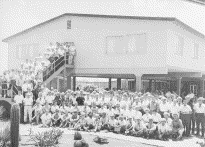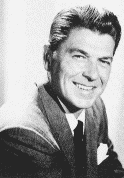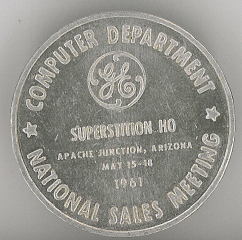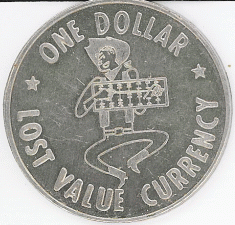|
NATIONAL SALES MEETING AGENDA <Part 1>
<Part 2>
<Part 3>
<Part
4> <Part
5> <Part
6> |
|
|
Frontiers of Progress Expanding Frontiers Resources for Expansion Planning the Expansion Resources for Development Crowding the Frontiers Planning the Breakthrough Applying the Resources The End Results Resources Behind the Scene |
Behind the Scene Activity Knowing the Ground Rules Applying Your Knowledge It Resources in the Field Where's the Pay-Off? Here It Comes Challenging Frontiers Our New Challenge Frontier Off -Shore
|
|
Table of Contents (cont) |
|
|
Off-Shore Sales Barter with Other Tribes New Mother Lodes Acres of Diamonds Scalp Counting The Great White Father Broad Frontiers
|
Far Frontiers and Outposts Near Frontiers Back at the Ranch Frontier Service Prospecting There's Gold in Them Hills II A PORTRAIT OF THE COMPUTER DEPARTMENT
|
|
Official Picture, 1961 National Sales Meeting
|
|
|
RONALD REAGAN
Hello: I'm Ronald Reagan speaking for General Electric. At General Electric, you know, "PROGRESS IS OUR MOST IMPORTANT PRODUCT". But, all progress must have a starting point. All great human enterprises begin at a frontier. The pioneering of hostile lands. ..the mushrooming of the Atomic Age with its mixed blessing of destruction and construction. ..the rolling back of space frontiers beyond the planets to the stars. ..and the beginning of the information-handling revolution. ALL these had -a common starting point --a frontier of PROGRESS. Webster has defined a frontier as: "An advanced or not fully explored region." That is an almost perfect description of where the computer industry is today--in an advanced or not fully explored region. The broad expanse of this region is almost limitless. General Electric Company, with its tremendous resources is continuing to invest in the exploration of this region through accelerated improvements of its present products and their related facilities, and through added research and development. General Electric recognizes the computer business is an exciting frontier. The traditional pioneering efforts of the Company in this field have already resulted in dramatic new technologies. Many of you are undoubtedly aware of the Company's major contributions--such as solid state computers and magnetic ink character recognition techniques. But---where and when did the exploration of this information handling frontier begin? Who initiated it? Was it the business machines manufacturers? Was it the Federal Government? Was it in 1954 when the first large scale. ..electronic computer system for business data processing was installed by General Electric. ..at Appliance Park in Louisville, Kentucky? The answer to these questions is, of course, NO. It was GENERAL ELECTRIC COMPANY. But the year was 1920! That was the year that General Electric engineers developed the first practical electric computer in the entire industry --a D-C calculating board. This computer reproduced in miniature hundreds of miles of transmission lines in vast power networks. 1920---Forty-one years ago. And, over the years General Electric has continued to acquire more computer systems know-how through wider scope of applications than any other organization. Forty-one years. That was a long time ago- beyond the memory of many in this audience. 1920---It was the year that Babe Ruth joined the Yankees--as a pitcher and hit 54 home runs... The year the 19th amendment permitted women to vote for the first time --and the 18th amendment closed man's last haven: the corner saloon! Man 0' War was a three year old--winning $166,140 for his owners that year!. ..and, the hopes and prayers of a war-weary world were pinned to the League of Nations first meeting at Geneva, Switzerland. It was the year when some of General Electric's top salesmen wore dresses. ...and bared their charms to a cold frontier! It was the year that General Electric first penetrated the computer frontier and inaugurated the information handling revolution. As Victor Hugo so aptly puts it in his "Les Miserables": "Would you realize what revolution is, call it progress: and would you realize what progress is, call it tomorrow. " As the 20' s rolled by, General Electric engineers continued exploring the frontiers, while its salesman was already carrying the ball. Then came the 1930's---and another step forward into the frontiers of computer progress. General Electric announced the A-C Network Analyzer--resembling a telephone switchboard in appearance, the machine was built before the mathematics were available, and from this computer came the mathematics that ultimately explained to the systems engineer how his transmission system really worked. These were the Gershwin years and General Electric was pioneering many other new ventures. Now---our salesman---was also beginning to be known. And... the frontiers were becoming more challenging. Prior to World War II--about 1938--GE engineers and scientists developed a differential analyzer for use in the study of Radar, rotating machinery, and airplane stresses. They were the only practical computers available to the United States at the start of World War II. During the war, the computer-control systems Page 1 |
|
| developed by General Electric for the B-29
were so accurate that fire control far exceeded that of any previously
developed plane in this country or abroad.
Following the war---while reviewing the past of those hard-sell years General Electric pioneered many computer frontiers. They were using differential analyzers at White Sands, New Mexico to obtain trajectory data for firing V -2 rockets. There was OARAC, a specialized development for the U. S. Air Force. Then came a "Robot Psychologist", known as a Psychological Matrix Rotator, developed for the Department of Defense. It is still used to literally "see" that the right man gets the right Army job. And, during the Korean War, many additional specialized computers were developed by the Company for controlling flight and gunfire of speeding jet planes during combat. It was not until late 1955, however, that General Electric decided to concentrate its computer activity into one component. At that time, some 200 engineers through-out the Company were pioneering in both development and applications of computers. At about the same time, the Bank of America and Stanford Research Institute were winding up a five-year development effort designed to give the Bank an Electronic Recording method of accounting. They called it ERMA. They had successfully developed a crude prototype machine that proved the feasibility of processing bank checks with magnetic ink character recognition techniques. But much still remained to be done. The Bank of America needed a top manufacturer to refine the complex and cantankerous prototype into a workable, practical electronic system. The Bank of America was also knocking at the frontiers of progress. What they did here is a remarkable story. Let's listen.
This is the story of ERMA and Seth Clark Beise. He heads up the Bank of America. This bank has been around for a long time and seems apt to be around for a long time to come. For Seth Clark Beise is a good businessman and here in 1949, the bank is doing well, --it gets more business each year. Seth Clark Beise frets a little. He knows he still lives by the good sound business principles that built Bank of America up to the largest bank in the country. Of course, he doesn't like the uncontrollable factors that face every banker these days --such as rising labor costs, climbing material costs, soaring equipment costs---but he figures that he can live with them as well as his competitors can. This morning, he had listened to a presentation by a Business Machine manufacturer. Seth Beise listened carefully, but after 30 minutes, was sure Business Machines Manufacturer could not satisfy his needs. I am the Spirit of Computers. There is a better way to up-date your business methods. There are great advances coming, in electronics -Mr. Beise - in electronics -which you can use in your business. Come with me into the future---l0 years. from now---in 1959---listen to your Vice President and executive officer for operations. Come with me into the future --and listen to Frank M. Dana. Soon after the close of World War II, it became evident to us at Bank of America that a better tool must be developed to help us process the steadily increasing volume of paper work flowing in and out of our branches every day. The need was most acute in the area of commercial bookkeeping -the Checking Account. To solve our paper work problem, we looked for a system which would operate at a higher speed than anything known at that time --- be completely accurate eliminate routine and repetitive chores handle all sizes and quality of paper and be economical to install and operate. Electronics offered the most promise in reaching our objective. But this field was relatively new and we felt that neither we, nor the banking business as a whole, could wait for business machine companies to develop this equipment in their normal course. The paper work problem was too pressing. Accordingly---in 1950, Clark Beise, now our president, contacted Stanford Research Institute and told them what we wanted. Their engineers went to work, and in late 1955, completed the prototype ERMA ---- an automated system which could completely process commercial accounts. Satisfied that ERMA was practical and economical, we selected General Electric to adapt electronic developments of the preceding six years and to manufacture the system for us and, through acquisition of our rights, for other banks as well. Thank you, Mr. Dana. General Electric got the order and at that moment set into motion a project that took over three years of research, development, engineering and production necessary to turn the prototype into a manufactured working installation. It meant not only the gathering of the the right equipment but also building of a new plant and the expansion of its computer business. The man in charge is Mr. Clair Lasher, General Manager of the General Electric Computer Department. Yes, gentlemen, we got the order, the largest commercial computer order ever placed--30 million dollars. The chain of events that put General Electric on the track of this order began in the late 1955's -- with a short notice in the Stanford Research Institute quarterly review. Page 2 |
|
|
An alert General Electric opportunist, well aware of the computer studies underway in General , Electric had circled the notice of ERMA and bucked it to Syracuse. The newly formed Industrial Computer Section was electronified into action. So a representative was sent to the Bank of America, ---but there were 29 experienced competitors who also recognized the value of the opportunities involved. Let me emphasize here that it was no superman who called on the Bank of America. Rather, it was a confident, dedicated aggressive General Electric salesman---highly motivated to make the Company's new computer business a success---one who recognized that the reward would be worth the thirty million dollar risk---one who recognized how important the impetus of this order would be in gaining a foothold in this new market. The Bank of America had already invested more than two million dollars in a prototype. They knew, or thought they knew, what they wanted. While 29 competitors tried to persuade Mr. Beise to change his mind and work with available business machines "because they knew and so did we ---that a complete re-design of the S. R. I. ERMA prototype was required," ---we agreed to adapt their design wherever we could---without restricting our own ingenuity. The contract did not mention the S. R. I. ERMA. It specifically called for automating the Bank's Checking account bookkeeping system. Awarding of the contract was announced on April 25, 1956. From a four-man team with nothing but office space, ---we had committed the company to a new business. Engineering work began immediately in Palo Alto, California, close to the customer and S. R. I. in rented facilities. We built a team of engineers. But we needed space to operate---space to manufacture. It was the beginning of a new General Electric Department. Within six months from the Department's establishment in Phoenix, Arizona, manufacturing was begun in a 50,000 square-foot rented facility known as the Peoria Avenue Plant. One year later, ground was broken for the permanent home of General Electric's new Computer Department. With the Peoria Avenue Plant already bursting at the seams, time was at a premium. Construction proceeded rapidly. It had to. Explosive growth of the Department's business required bringing together the functions which were widely-scattered over a 25-mile radius. The accelerating tempo of the computer business couldn't wait. Before the building was completely finished, administrative personnel began moving in --- just six months from the beginning of construction. The Computer Department is proud of its new building---and justly so. Since its dedication by Arizona Governor Paul Fannin and Department General Manager Clair Lasher, the building has become the home of many computer firsts. We have developed magnetic character reading --- the machine readable language that is also eye-readable. In September 1959, we announced the first completely-automated banking system using magnetic character reading --the Bank of America's ERMA system. This is ERMA, Gentlemen, the machine that put General Electric into a young, vigorous and growing business, which today is valued at 1. 5 billion and will reach 2. 8 billion by 1964. Now that the real ERMA is working, she supports herself, and has paid back most of the allowance advanced to her while she was growing up. Largely due to the contributions of this young lady, we are capturing an increasing share of the computer market. Direct spin-offs from ERMA include. ..the GE 210 Computer System, sold to 14 leading banks--an order for automation of another banking function transit, --- and new applications of Magnetic Ink Character Reading. For example, MICR will be used by the General Electric Credit Corporation. Spunoff from MICR, we are in these new product lines encoders, sorters, and re-entry printers. With our medium sized 225 Computer System and our Industrial Computer line---General Electric is now a major factor in the Computer industry---Most important, we have made a major customer happy. Here's what Mr. Beise, President of the Bank of America had to say during a recent press conference. "ERMA is a new concept in banking. Its effects will be far reaching, touching such things as bank architecture and new banking services undreamed of today. Because of electronics, we have an eighteen months' lead time over all other banks in this amazing era. ..thanks to General Electric." Seth Clark Beise is a changed man. His business will be a changed business. He is combining sound business principles with modern business technology through creative, customer oriented selling, coupled with a willingness to accept a business challenge and the attendant risks. Both General Electric Company and the Bank of America are in the Age of the Computer. Thank you, Mr. Lasher. The ERMA story represents another milestone in General Electric's march through the frontiers of progress. This page 3 documentary of General Electric's 41 years of computer experience has been both exciting and informative to me. It's quite a history. Many more chapters will unfold in the years ahead. Plans are being mandatory to carry General Electric to a leadership position in the information-handling revolution. And now, let's turn the program over to the salesman who life parallels that of the General Electric Company's milestones of progress in the computer industry, Bob Sheeley.
|
|
|
|
|







